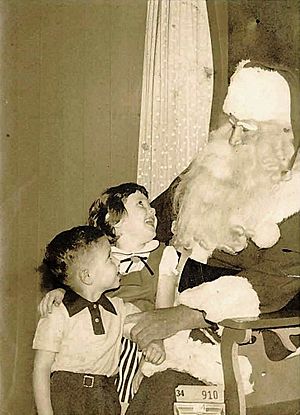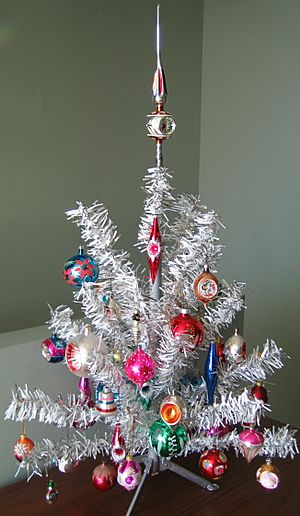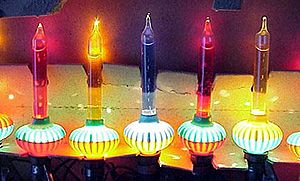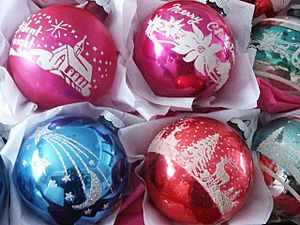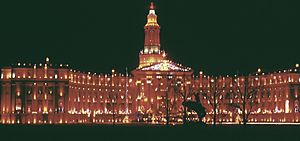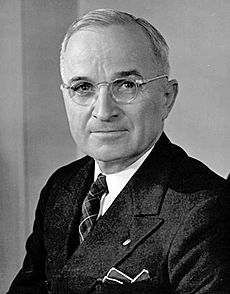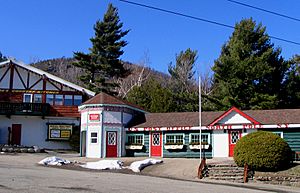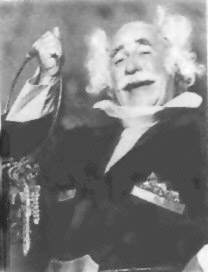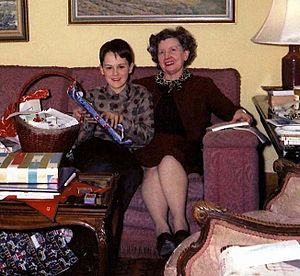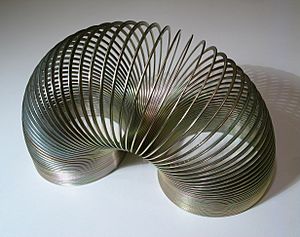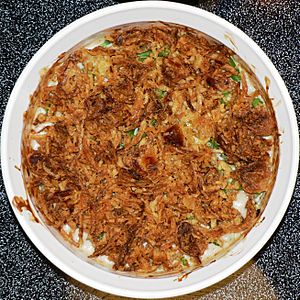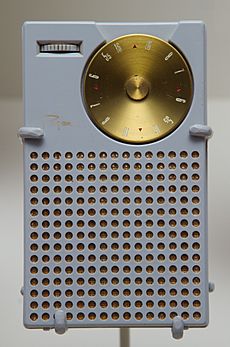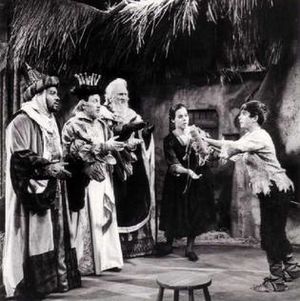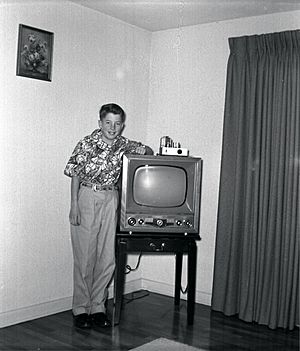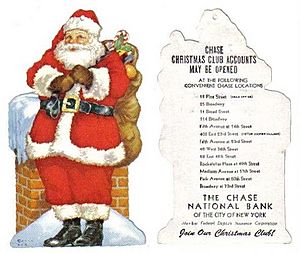Christmas in the United States (1946–1964) facts for kids
Christmas in the United States after World War II (from 1946 to 1964) was a time of peace and growth. Americans celebrated Christmas in big ways, enjoying many new holiday foods. Some popular movies, foods, toys, and TV shows from this time became lasting American Christmas traditions.
Before this period, America often relied on Germany for Christmas ornaments, toys, and even some customs. But after the war, the U.S. started making its own Christmas decorations and toys. These American-made items were often cheaper than those from Germany. Old traditions like visiting Santa Claus at department stores and writing letters to Santa at the North Pole continued. But this era also brought new traditions that are still around today.
For example, NORAD started tracking Santa's sleigh on Christmas Eve in 1955, and it's still a yearly tradition! The stop-motion animated film, Rudolph the Red-Nosed Reindeer, is still shown on TV every year, more than 50 years after it first aired. Also, Dr. Seuss's book How the Grinch Stole Christmas! from 1957 became a classic Christmas story.
Many "firsts" happened during these post-war years. These include the first White House Christmas card, the first Christmas postage stamp, and the first opera made for television (Amahl and the Night Visitors). There was also the first Christmas Day basketball game and the first Elvis Presley Christmas album. This time also saw the creation of classic toys like Candy Land, Mr. Potato Head, and Barbie.
Contents
Christmas Trees: Types and Trends
During the post-war years, Americans had many choices for their Christmas trees. Real trees had become very popular since Christmas tree farms started supplying them to cities in the 1920s. But artificial trees made of bristles, shiny aluminum trees, and flocked trees (covered in fake snow) also became popular choices.
Real Christmas Trees
In 1900, only one out of five American families had a Christmas tree. Even though America had plenty of real trees, it was hard and costly to get them from the wild. But in the early 1900s, Christmas tree farms began sending real trees to big cities. By the 1920s, real trees were common in American homes, replacing artificial ones.
Artificial Christmas Trees
Artificial trees made of goose feathers were used in American homes since the 1880s. In the 1930s, a British company called Addis Brush Company started making artificial trees from green-dyed bristles. They supplied many of these trees to Britain after the war. However, Americans were not very interested in these trees and preferred real ones.
Shiny Aluminum Trees
In 1950, the Addis Brush Company created an aluminum Christmas tree called the Silver Pine. It came with a special floodlight and a spinning color wheel. Other companies also started making aluminum trees. The Aluminum Specialty Company in Manitowoc, Wisconsin, made over a million aluminum trees between 1959 and 1969. Their most famous tree, the "Evergleam," sold for about $25.
These aluminum trees looked very modern and "Space Age," fitting well with the new home styles of the time. You could even add a spinning Christmas tree stand to make them more exciting. However, sales of aluminum trees dropped after they were made fun of in the 1965 TV special, A Charlie Brown Christmas.
Flocked Christmas Trees
In the 1960s, flocked Christmas trees became popular. These trees were coated in a special, snow-like substance and came in colors like purple, gold, pink, and even black. People who loved fashion suggested choosing a new Christmas tree theme each year with matching ornaments. Real trees became popular again in the 1970s when country-style arts and crafts were in fashion.
Christmas Tree Decorations
The post-war years brought changes in how Christmas tree ornaments were made. Companies like Shiny Brite started making many inexpensive glass ornaments. New items like bubble lights and affordable, lighted tree toppers also appeared.
Toppers and Stands
After the war, clear, molded plastic tree toppers that lit up from the inside became popular. These often looked like angels or stars. While Santa Claus and other Christmas figures were also made into lighted toppers, the star and angel, popular since the Victorian era, remained favorites. Glass spire ornaments were also common tree toppers.
The first tree stands that held water (to keep real trees fresh) appeared in the 1940s. In the 1950s, tin Christmas tree stands decorated with holiday pictures were made by the National Outfit Manufacturers Association. These stands are now popular collector's items.
Christmas Lights
Bubble lights were invented in 1935. They became very popular on the Christmas market in 1946, after wartime shortages ended. These lights had a sealed glass tube with a colorful liquid that bubbled when heated.
Other companies also made their own versions of bubble lights and other new lighting ideas. In 1946, Sylvania introduced fluorescent pastel lights. In 1955, NOMA made flashing lights. In 1958, GE launched "Lighted Ice Bulbs," which were blue bulbs covered with "ice" crystals. Small "Fairy Lights" were brought from Europe in 1950. These eventually turned into the inexpensive mini-lights we see today.
Ornaments
German glass ornaments were first brought to America by Frank Winfield Woolworth in the 1880s. These ornaments were expensive because they took a lot of work to make. Most Americans could only afford one or two each year. But before World War II, American companies started making cheap, mass-produced ornaments. This meant almost any American could have a large collection of Christmas ornaments without spending much money. With a few changes, Corning Glass's light bulb machines could make 2,000 blank glass ornaments a minute! Ornament companies would then buy these to decorate and sell by the dozen.
Shatter-resistant and shatterproof ornaments were also created to make Christmas safer for pets.
Shiny Brite Ornaments
Max Eckhardt's Shiny Brite company made colorful glass ornaments in many sizes and shapes during this time. They were sold in boxes of six or twelve, and you could see them through the clear cellophane windows on the box lids. Besides the traditional reds and greens, new bright colors like turquoise, orange, and purple were used.
Some ornaments had glittery bands of mica, while others were decorated with pictures of snowy scenes, sleigh rides, carolers, and poinsettias. Some even had shiny indents that reflected the light. In the early 1950s, clear glass balls decorated with colored bands or glitter appeared. Molded plastic Santa Clauses, angels, and snowmen were also cheap and easy to find.
Outdoor Christmas Lights
McAdenville, North Carolina, claims to be the first town to use outdoor Christmas lights. The Library of Congress says that "the tradition of decorating evergreen trees with Christmas lights dates back to 1956 when the McAdenville Men's Club thought of decorating a few trees around the McAdenville Community Center."
While the Rockefeller Center Christmas Tree had "lights" since 1931, it didn't have real electric lights until 1956. Philadelphia's Christmas Light Show and Disney's Christmas Tree also started in 1956. Even though GE sponsored community lighting contests in the 1920s, most Americans didn't start decorating their homes with outdoor Christmas lights until the mid-1950s. Strings of lights slowly began to appear on mantels and doorways inside homes, and on roofs and porch railings outside.
National Christmas Tree
The tradition of having a National Christmas Tree in Washington, D.C. began in 1923. A 48-foot Balsam Fir tree from Vermont was placed outside the White House. On Christmas Eve, President Calvin Coolidge lit the 2,500 red, white, and green electric bulbs on the tree.
In 1941, President Franklin D. Roosevelt moved the tree to the White House grounds. It stayed there until 1954, when it was moved back to the Ellipse. In 1946, the lighting ceremony was shown on TV, though not to everyone. From 1948 to 1951, President Harry S. Truman lit the tree by remote control from his home in Independence, Missouri. But in 1952, he stayed at the White House for the ceremony. In 1953, the ceremony was widely shown on TV, and President Dwight D. Eisenhower's speech was broadcast on the Voice of America in 34 languages.
In 1954, local business people got involved and greatly expanded the event into the Christmas Pageant of Peace. This pageant focused on lighting the Christmas tree and included things like a life-sized nativity scene. From 1954 to 1972, a tree was cut from a different U.S. state each year and brought to the Ellipse. The tree lighting ceremony was then followed by other Christmas presentations throughout the holiday season.
Santa Claus Traditions
Many traditions around Santa Claus stayed the same after the war. People still visited Santa at department stores and wrote letters to his workshop at the North Pole. But new things were added, like Santa's Workshop (one of the first theme parks in the U.S.) and NORAD's tracking of Santa's sleigh. In Cleveland, Ohio, a character called Mr. Jingeling entertained shoppers every year at Halle's Department Store.
Santa's Workshop Theme Park
In 1949, one of the first theme parks in the United States, Santa's Workshop, was built near Whiteface Mountain in New York State. The idea for the park came from a story a businessman named Julian Reiss told his daughter about a baby bear visiting Santa's workshop.
The park has tame deer, storybook characters, and other fun attractions. On September 2, 1951, a record 14,000 people visited the park in one day. In 1953, the United States Postal Service made North Pole, New York, an official "Rural Postal Station." That same year, the park's Santa Claus and his reindeer took part in the Pageant of Peace in Washington, D.C., and the Macy's Thanksgiving Day Parade in New York City. A Nativity Pageant was added to the park in 1954.
NORAD Tracks Santa

In 1955, an advertisement in Colorado Springs, Colorado, told children to call Santa Claus. But because of a mistake, the phone number printed was for the Continental Air Defense (CONAD). Colonel Harry Shoup was on duty on Christmas Eve 1955 and received many calls from children asking about Santa. He told his staff to give a current location for Santa to any child who called. Three years later, the North American Aerospace Defense Command (NORAD) was formed, and the NORAD Tracks Santa service continued.
Mr. Jingeling
Mr. Jingeling, known as the Keeper of the Keys to Santa's Workshop, was created in 1956. He started as a radio voice to promote toys sold at Halle's Department Store in Cleveland, Ohio. Mr. Jingeling quickly became popular and was a yearly sight at Halle's, where he entertained shoppers in the toy department. He also appeared on a local children's TV show, telling stories and singing songs, always reminding viewers to visit Halle's.
Popular Toys
The huge popularity of Christmas toys after the war was partly inspired by Clement Clarke Moore's poem A Visit from St. Nicholas. In the poem, Saint Nicholas is shown as a "jolly old elf" with a belly that shakes like "a bowlful of jelly," who comes down the chimney with a bag of toys.
In the 1800s, Germany was the world's toy-making capital. But German toys were expensive in America because of high shipping costs. Toy prices dropped when German toymakers started making toys in large numbers under the direction of Frank Winfield Woolworth. These toys were then sent to Woolworth's warehouses for packaging and selling.
When German toys were not available in America during World War I, toy manufacturing in the U.S. really took off. The Great Depression caused a small slowdown, but World War II boosted it again. After the war, American families were eager to settle down, have children, and give them the wonderful Christmases they might have missed.
The post-war years saw the creation of toys that are still made today. These include Candy Land, Cootie, the hula hoop, Barbie, and Etch A Sketch.
Television helped make Christmas toys even more popular. Manufacturers started advertising toys directly to children, bypassing parents. Mr. Potato Head was the first toy advertised on television, and its sales reached over $4 million in its first year! Play-Doh's sales also soared after it was advertised on popular children's TV shows like Ding Dong School and Captain Kangaroo.
Christmas Cards
The first White House Christmas card was sent in 1953, during President Dwight D. Eisenhower's time. President Eisenhower was an amateur artist and worked with the head of Hallmark Cards on the project. During his two terms, the Eisenhower White House sent out 38 different cards and prints, many featuring the President's own artwork. This tradition continued with Jacqueline Kennedy's artwork on a 1963 card, which helped raise money for a national performing arts center.
In the early post-war years, cards had traditional pictures and messages that comforted Americans who were tired from the war. But as the 1960s approached, new, more grown-up cards called "Slim Jims" appeared. These cards showed Santas driving cars with big tail fins and "beatniks" (a type of cool, rebellious person) giving greetings in their own slang. These stylish cards stayed popular into the 1960s, often making fun of new trends and world events. Family photo cards and newsletters (written or typed by busy moms) also became common in the 1960s.
Hallmark also started featuring African American culture on greeting cards in the 1960s, as well as modern images like elves with Beatle haircuts and Christmas trees in bright, Warholesque colors. Sometimes, "Happy Christmas" replaced "Merry Christmas." In 1961, Americans mailed 50 billion Christmas cards. In 1962, America's first Christmas postage stamp was issued. This caused a small stir among those who felt it went against the separation of church and state.
Holiday Foods
Mamie Eisenhower's Million-Dollar Fudge Recipe was a favorite holiday treat during the Eisenhower White House years. It first appeared in a cookbook called Who Says We Can't Cook? in 1955. Mamie Eisenhower's husband, Ike, named the recipe.
The year 1955 also saw the first appearance of Green Bean Casserole, a dish that is still a holiday favorite in America. Its ingredients include green beans, cream of mushroom soup, and French's Fried Onions on top. The casserole was created by Campbell Soup Company to promote their cream soups. French's reports that half of all French's Fried Onions are eaten during Thanksgiving, Christmas, and Easter.
Cookie cutting and decorating became very popular during the "baby boomer" years. Christmas cookie cutouts of reindeer, trees, stars, and bells were fun for kids and dads. Moms would pack their homemade cookies into Tupperware containers and take them to cookie swap parties with friends. Red plastic cookie cutters replaced metal ones during the war when metal was scarce. You can still find these plastic cutters at garage sales and flea markets today.
A popular snack during the 1955 holiday season was Chex Party Mix. It was a mix of Wheat Chex, Rice Chex, Corn Chex, nuts, pretzels, and a dressing made with melted butter, Worcestershire sauce, and onion and garlic powders. This treat is still a popular holiday snack.
Teenagers and Christmas
Gifts for Teens
Gifts for teenagers after the war included face powder, radios, telephones, and cars. In the early 1950s, Angel Face powder was advertised as "the perfect girl-to-girl" Christmas gift. The first transistor radios came out just before Christmas 1954. They were a luxury item, costing about $49.95 (which would be about $322 today). A leather case and earphone cost an extra $11.45. But by the end of the decade, prices dropped quickly, and an 8-transistor radio could be bought for less than $10.
Another popular gift was the sleek, oval-shaped Princess telephone, introduced in the early 1960s. This phone came in various colors, including pink, turquoise, and cream. When one of Mattel's Barbie doll outfits included a Princess phone as an accessory, it became a fashion trend. By 1963, many Baby Boomers were old enough to drive. For the first time, middle-class families started buying cars for their children.
Films and Music for Teens
20th Century Fox's 1956 Christmas movie was The Girl Can't Help It. It had a side story that made fun of teenagers and rock 'n' roll music. But it accidentally became one of the strongest celebrations of rock music ever shown in a film.
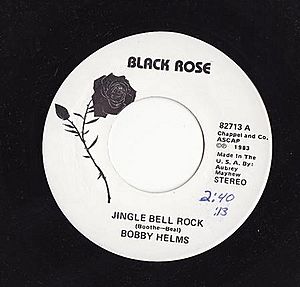
In December 1961, Disney Studios released Babes in Toyland, a movie version of an old musical. It starred popular teen actors Annette Funicello and Tommy Sands. Even though it had new, jazzy songs, the movie wasn't a huge hit or a complete failure. Its giant toy soldiers later became part of the Disneyland and Walt Disney World Christmas Parades.
Two rockabilly/rock and roll songs from the late 1950s became very popular. "Jingle Bell Rock", written by Joe Beal and Jim Boothe, was recorded by Bobby Helms in 1957. It's considered the first rock and roll Christmas song and has been on the Billboard charts six times since it came out. It's second in popularity only to "White Christmas". "Jingle Bell Rock" reached #6 in its first year, even though it was released just two days before Christmas.
"Rockin' Around the Christmas Tree", written by Johnny Marks and recorded by Brenda Lee in 1958, was another rock and roll Christmas song. It wasn't very popular in its first two years, but it reached #16 on the Billboard pop chart during the Christmas season of 1960. Eight million copies were sold over thirty years.
Christmas Music
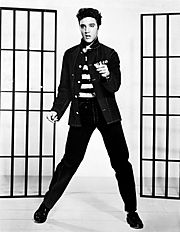
Elvis' Christmas Album came out in October 1957. It was the first of only two Christmas albums Elvis ever recorded. The album had eight Christmas songs and four gospel songs. "Santa Claus Is Back In Town" and "Santa Bring My Baby Back (to Me)" were written just for this album. Elvis's version of Ernest Tubb's 1949 hit, "Blue Christmas", made it a holiday favorite. As of 2007, Elvis' Christmas Album is the best-selling holiday album of all time, with 9 million copies sold.
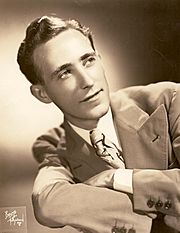
"Rudolph the Red-Nosed Reindeer" was written in 1948 by Johnny Marks. It was based on a 1939 poem by Robert L. May who created Rudolph for his job at Montgomery Ward. The song tells the story of a reindeer whose bright red nose helps Santa's sleigh through the fog on Christmas Eve. Gene Autry's 1949 recording stayed at #1 for a week and made the song famous everywhere. Only "White Christmas" has sold more copies.
Autry had another hit in 1950 with "Frosty the Snowman". This song was written as a direct attempt to create another success like "Rudolph." It tells the story of a magical snowman who has fun adventures with children. In 1963, "Frosty" reached its highest spot ever at #13, in a version by The Ronettes.
Spike Jones's version of "All I Want for Christmas Is My Two Front Teeth" reached #1 on the pop charts in 1951. The song was written in December 1944 by a music teacher named Don Gardner. He noticed that most of his students were missing their front "baby" teeth. Inspired, he wrote the song in 30 minutes. In Spike Jones's original recording, a grown-up pretends to be a lisping child who can't whistle. Nat King Cole also sang this song.
"The Little Drummer Boy", based on an old Czech folk song, was written by Katherine Kennicott Davis in 1957. The song tells the story of a poor young boy who, having no gift for the baby Jesus, plays his drum. Mary approves, and the baby smiles at the boy. The 1958 version by the Harry Simeone Chorale is the most famous. It holds the record for being in the Top 40 for five Christmases in a row.
"Silver Bells" was written by Jay Livingston and Ray Evans. It was first sung by Bob Hope and Marilyn Maxwell in the film The Lemon Drop Kid and recorded by Bing Crosby and Carol Richards in 1952. The song was inspired by The Salvation Army bellringers and is one of the few Christmas songs about the city. The song was originally called "Tinkle Bell," but Livingston's wife reminded him that "tinkle" had another meaning. "Silver Bells" is #13 on ASCAP's list of most-played holiday songs.
"I Saw Mommy Kissing Santa Claus" was written by Tommie Connor in 1952 and first recorded by 13-year-old Jimmy Boyd. The song reached #1 on the Billboard charts in 1952 and on the Cash Box Magazine chart in early 1953.
"Santa Baby" was written by Joan Javits and Philip Springer in 1953. The song is a funny look at a woman's Christmas list, where she asks for very expensive gifts. "Santa Baby" was first sung and recorded by Eartha Kitt and became a huge hit, reaching #4 in 1953.
The Jackson 5 Christmas Album was the only holiday album released by the famous family group The Jackson 5. Released in October 1970, the album showed off the brothers' singing. Lead singer Michael Jackson is featured a lot on the album. It includes the Jackson 5's hit version of "Santa Claus Is Comin' to Town". Their versions of "I Saw Mommy Kissing Santa Claus" and "Santa Claus Is Coming to Town" are still often played on the radio during the holidays.
The album was number one on Billboard magazine's special Christmas Albums chart for four weeks in December 1970, making it the best-selling holiday album that year. It has sold over 3.5 million copies worldwide.
Christmas Literature
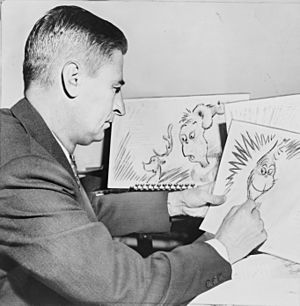
In 1957, Dr. Seuss's How the Grinch Stole Christmas! was published. The story, with its rhyming words and the author's drawings, is about a grumpy character called the Grinch. He tries to stop Christmas from coming by stealing all the gifts, decorations, and other holiday items from the happy Whos of Whoville. But even with his efforts, Christmas arrives anyway.
The Grinch then realizes that Christmas is about more than just presents and decorations. The book criticizes how Christmas can become too focused on buying things and makes fun of those who try to profit from the holiday. The story was made into a short animated film for television in 1966, with a script by Seuss and narrated by Boris Karloff. Later, it was adapted into a Broadway musical and a feature film in 2000 starring Jim Carrey.
In 1960, at 100 years old, Grandma Moses illustrated Clement Clark Moore's Christmas poem, A Visit from Saint Nicholas, for a book called The Night Before Christmas. The book was published after she passed away in 1961.
Christmas Films
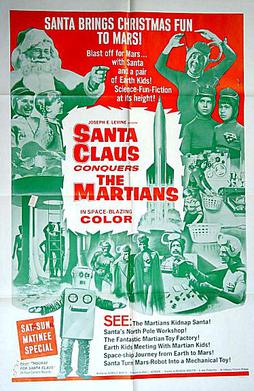
The years right after World War II saw the release of two very popular Christmas movies in the U.S.: It's a Wonderful Life (1946) and Miracle on 34th Street (1947). Moviefone listed these two movies as number two and three on their "25 Best Christmas Movies of All Time." The Times of London also ranked them highly. It's a Wonderful Life, starring James Stewart, has been called a movie that shows the "family values of small-town America just after WWII."
Santa Claus Conquers the Martians (1964) often appears on lists of the worst films ever made. Paul Jacobson, the film's producer, wanted to create a "Yuletide science fiction fantasy" for movie theaters. He hoped to offer something for children during a time of year when there weren't many kids' movies besides the yearly Disney film.
In Jacobson's movie, Martians kidnap Santa Claus because they want to bring fun to their bored, TV-obsessed children. Once on Mars, Santa makes lots of toys using a special machine, stops a grumpy bad guy, and brings joy to everyone. Santa Claus Conquers the Martians has been made into a book, a musical, and has become a holiday cult classic. Child actress Pia Zadora played one of the Martian children and later said, "It was very well done, considering it was shot twenty years ago... and really is very entertaining. It's become a Christmas classic, really."
Christmas Television
Christmas television shows are mostly about gift-giving and Santa Claus, or about feelings of home, memories, and childhood. The religious meaning of Christmas is rarely shown on TV, as it might not be understood by all Americans.
In 1949, Gian Carlo Menotti was asked by NBC to write an opera for television. After some delays, he finished Amahl and the Night Visitors five days before it was set to air on Christmas Eve 1951. Menotti's work was inspired by Hieronymus Bosch's painting, The Adoration of the Magi. The composer himself appeared on screen to introduce the opera.
About five million people watched the show, which is still the largest audience for a televised opera in America. Critics praised it, with The New York Times saying that "television, operatically speaking, has come of age."
The opera was popular not only because of its story about a disabled shepherd boy healed on the first Christmas Eve, but also because it worked well with the limits of television. Instead of big theater effects, it created a close, personal feeling that was perfect for TV.
In 1953, Amahl was shown in color. It was the first opera written for television, the first show in the Hallmark Hall of Fame series, and the first Christmas TV special to become a yearly tradition. The opera was shown on NBC from 1951 to 1966, with many of the original actors and crew.
On December 18, 1962, NBC aired the first animated Christmas special made just for television, Mister Magoo's Christmas Carol. It was based on Charles Dickens's story, A Christmas Carol.
On December 6, 1964, NBC aired Rudolph the Red–Nosed Reindeer. This stop-motion animated special was made by Rankin/Bass. It was based on a 1949 song by Johnny Marks, which was based on a 1939 poem by Robert L. May. The show has aired every year since 1964, making it the longest-running Christmas TV special.
On December 9, 1965, CBS aired A Charlie Brown Christmas. Later, in 2001, ABC first aired it. On December 8, 2002, ABC aired Charlie Brown's Christmas Tales, and on December 9, 2003, ABC aired I Want a Dog for Christmas, Charlie Brown.
Christmas Clubs
Christmas clubs were savings programs first offered by banks in 1909. The idea was simple: bank customers would put a set amount of money into a special savings account each week. Then, they would receive all the money later to use for Christmas shopping.
One radio show episode used Christmas clubs as a funny plot point. In a December 23, 1949, episode of Life of Riley, the main character, Chester Riley, tried to take out his $2 Christmas club money. But he found out his account had many fees, like for the passbook and for taking money out early. In the end, poor Riley actually owed the bank 25 cents!
See also
 In Spanish: Navidad para niños
In Spanish: Navidad para niños


